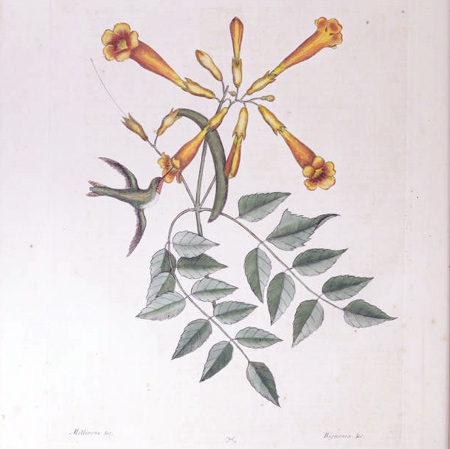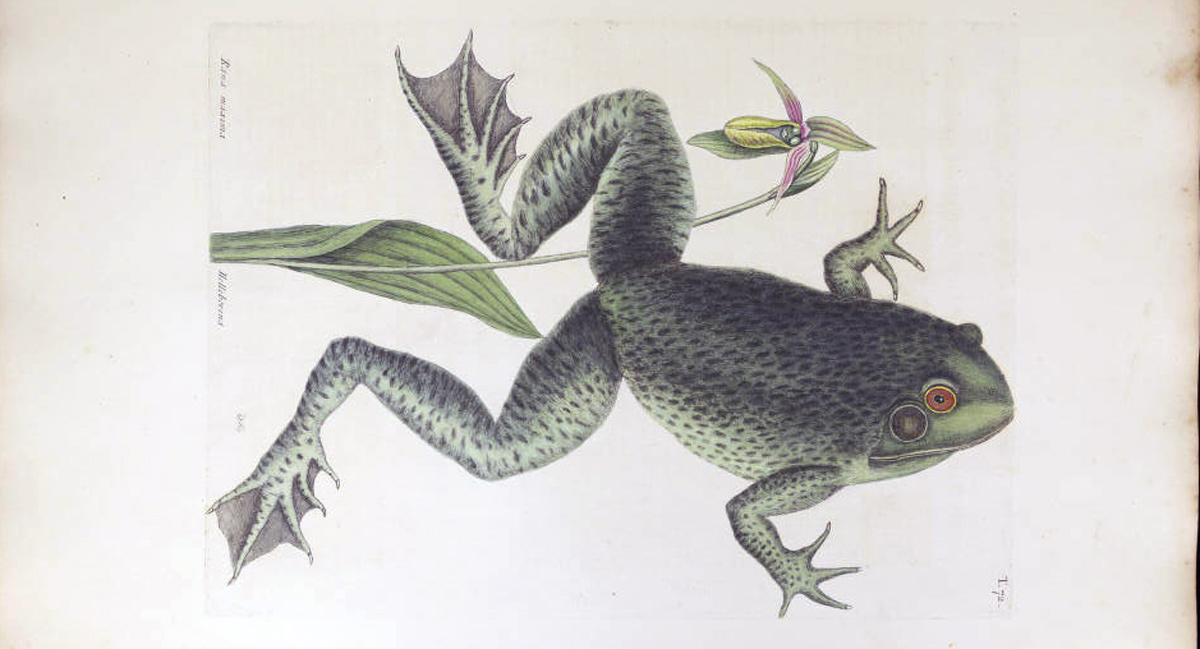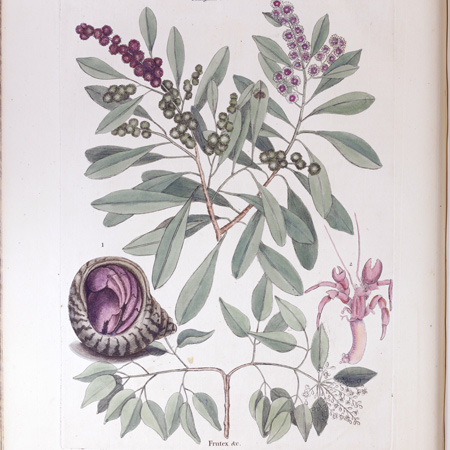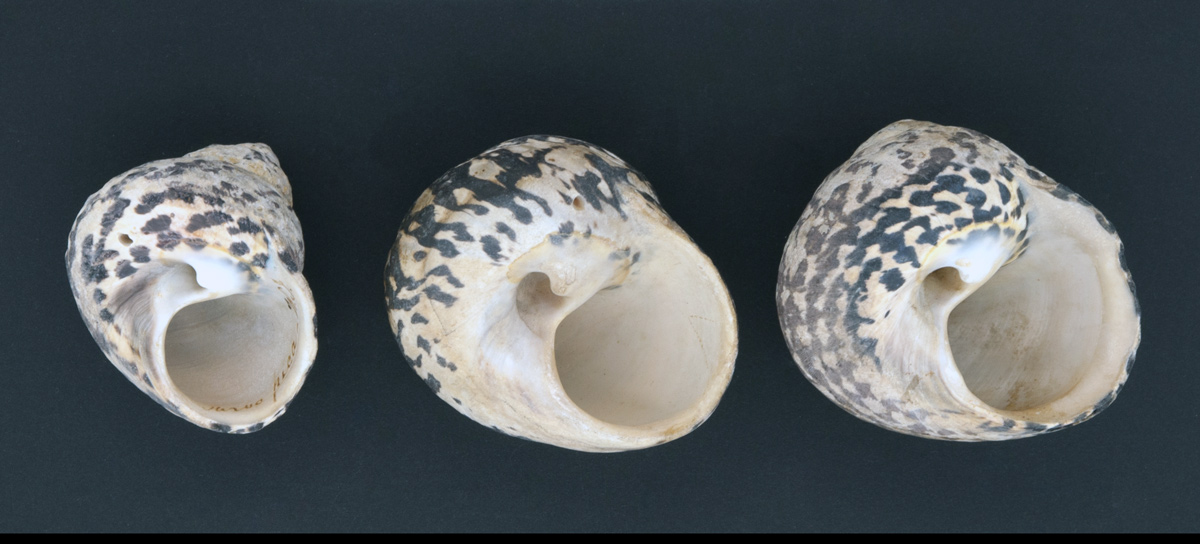Step back into history
Exhibit marks 300th anniversary of naturalist Mark Catesby’s arrival in Carolina colony
Imagine traveling in time to an era when you can observe the Carolina Parakeet, Ivory-billed Woodpecker and Passenger Pigeon — species that have vanished. A visit to the exhibit Catesby in the Carolinas might be the next best thing.
The exhibit, co-hosted by University Libraries and McKissick Museum, showcases the university’s collection of English naturalist Mark Catesby’s works — including the monumental volumes, Natural History of Carolina, Florida and the Bahama Islands (1729-1747) — by pairing them with specimens from the museum and A.C. Moore Herbarium. Visitors to the exhibit will have an opportunity to experience to some extent what Catesby saw 300 years ago as they view not only Catesby’s scientific and artistic works but also some of the animals, birds, reptiles, fish, shells and plants that might have inspired them.
The collaboration for the exhibit grew from an idea by Charles Nelson, senior research director of The Mark Catesby Centre, which is part University Libraries.
“The development of Charles Nelson’s initial concept creates the most comprehensive presentation of Catesby’s work and what motivated him yet assembled,” says Catesby Centre director David Elliott. “The diverse combination of materials in the exhibit helps us understand not only the world he knew but why this understanding is important to us today.”
Banner image: “Parrot of Carolina and Cypress of America" — The Carolina Parakeet was first scientifically described by Catesby. Once numbering in the millions, the last captive Carolina Parakeet died at the Cincinnati Zoo in 1918. They were likely wiped out by hunting as they often destroyed crops and were prized for their colorful plumage. Catesby shows the parakeet with the bald cypress (Taxodium distichum), a conifer that isn't evergreen and is common mostly in swamps in the coastal plain.
During two trips in the early 1700s, Catesby (1683-1749), an artist, self-taught naturalist and explorer, spent 11 years trekking through the wilderness of present-day Virginia, Georgia, the Carolinas and the Bahamas. Incorporating knowledge from Native Americans, enslaved people and colonists, he wrote about and sketched the plants, animals and environments he encountered. Published by subscription in installments from 1729 to 1747, Catesby produced the first scientific account of the flora and fauna of North America.

"Humming-Bird and Trumpet-Flower." The scientific name for the Trumpet-Flower is Campsis radicans.
The two massive volumes contained 220 illustrations, which were revolutionary in style and quality, and influenced later artist-naturalists such as John James Audubon.
“Catesby didn't just write about what he saw; he drew what he saw. And unlike other scientists of the time who would have someone else illustrate their work, he learned to engrave so he could do it himself,” says Michael Weisenburg, associate director of the Irvin Department of Rare Books and Special Collections. “He also hand-colored all of his illustrations with help from his wife and children.”
Christian Cicimurri, curator of collections at McKissick Museum, adds that instead of a typical engraver’s crosshatching to illustrate texture, Catesby individually engraved each feather for his bird etchings.
“That was much more labor intensive, but it was more lifelike in his perspective,” she says.
Cicimurri also points out that although Audubon is likely more recognized, Catesby collected his observations and illustrations 100 years earlier. Catesby also drew from his memory of live animals and plants in contrast to Audubon who worked from dead specimens.
“Catesby’s memory wasn't always perfect. Sometimes we come across a plant or animal we can’t identify,” she says.
For example, Herrick Brown, curator of the A.C. Moore Herbarium, recalls one of Catesby’s illustrations of a longnose or Florida gar that is depicted with a two-pronged branch of some sort. Catesby offers a long explanation of the plant and where it can be found in the pond margins from Carolina to Virginia.
“He’s obviously recalling something from memory, but we had no idea what the plant was,” Brown says. “Some folks just threw up their hands, but (botanist) James Reveal was determined.”
He noticed that one of the branches matches pretty closely with coastal doghobble, a shrubby plant commonly found around (what are now called) Carolina bays. But there's another branch in the illustration that is unidentifiable, and Brown says we can only surmise that Catesby just remembered things incorrectly or the plant doesn’t exist anymore.
On the other hand, Catesby is incredibly accurate in his descriptions of some habitats such as Carolina bays, a unique geological feature found in coastal areas.
“Catesby describes the whole suite of species to the extent that if I were walking through the woods as a botanist and came upon the margin of one of these isolated wetlands, I would experience exactly the species he writes about – even 300 years later,” Brown says.

UofSC has several copies of The Natural History of Carolina, Florida and the Bahama Islands, along with other Catesby works and additional natural history holdings. Weisenburg says it’s one of the stronger collections for University Libraries, which also includes botany, astronomy and gardening.

Catesby figured invertebrates such as sea biscuits, sand dollars, snails and clams, as accessory material in several plates. This image features the land hermit crab (Coenobita clypeatus) neatly tucked into the easily recognizable shell of the West Indian Topsnail (Cittarium pica) and button mangrove (Conocarpus erectus).
The dual exhibit has dual goals. Showcasing the university’s natural history holdings across campus will familiarize and help get people excited about the resources available to students, faculty members, researchers and the public. The exhibit also provides a better understanding of Catesby as a naturalist, an artist and an explorer while situating him in historical context with scientists who came before and after him.
For example, the exhibit at Hollings Library includes ancient natural histories, such as works by Roman naturalist and philosopher Pliny the Elder and move through medieval and early modern science, the Scientific Revolution and the Enlightenment. The exhibit also includes items from the university’s Audubon and Darwin collections, including first and second editions of Darwin’s The Voyage of the Beagle.
“We have an excellent Darwin collection, and several centuries of major scientific texts are held by the rare books department,” Weisenburg says. “The exhibit displays a fraction what we have. By looking at our collections, you can trace the development of human knowledge and the history of how we attempt to systematically describe nature.”
And, if nothing else, people who attend the exhibits will get a glimpse of Catesby’s beautiful and detailed illustrations — which Weisenburg jokingly referred to as “pretty pictures of birds and plants.” Although it may sound frivolous, he explains that Catesby’s talent as an artist was as integral as his descriptions to convey his scientific observations of New World and unfamiliar species to European audiences.
But, yes, the pictures are pretty.
“Catesby’s first volume focuses on birds, but in the second volume, he focuses more on animals – anything from large bison to literally dung beetles,” Cicimurri says. “I find many of his illustrations to be whimsical. They just bring joy.”
If you’re going
Catesby in the Carolinas is on display through Aug. 31 in the Ernest F. Hollings Special Collections Library (enter through Thomas Cooper Library) and at McKissick Museum in the lobby outside the main gallery on the third floor. The exhibits are free and open to the public 8:30 a.m. to 5 p.m. Monday through Friday.
Looking for a more immersive experience? Attend a free half-day Catesby at 300 Symposium 1-5 p.m. May 13 (in person and streaming).
Learn more: The university is preserving Catesby’s legacy at The Mark Catesby Centre, which promotes interest in natural history and is making his work available to students, scholars and the public. Images from both volumes of Natural History of Carolina, Florida and the Bahama Islands (1729-1747) have been digitized by University Libraries and can be viewed online: Vol. I and Vol. II.
